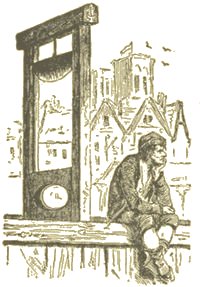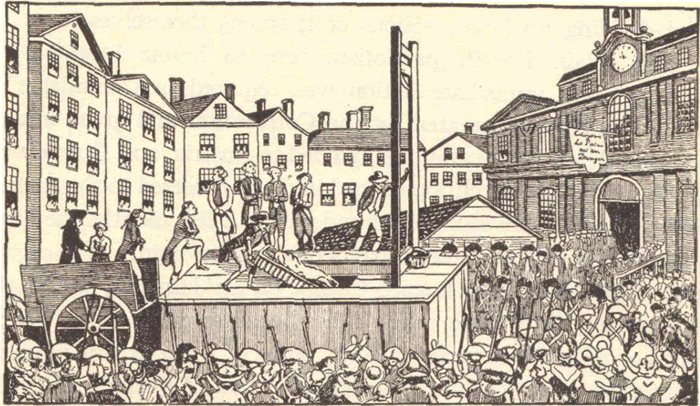Guillotine in the square before the Hotel de Ville. Illustration from a contemporary newspaper. Click here to enlarge the above image.
 The notorious guillotine played a significant and symbolic role during the French Revolution, becoming the primary method of execution and a powerful emblem of the revolutionary cause. Introduced in 1792, the guillotine was promoted as a humane and egalitarian method of execution, designed to deliver swift and relatively painless death. Its use was intended to reflect the Revolution's principles of equality before the law, as it was employed across all classes.
The notorious guillotine played a significant and symbolic role during the French Revolution, becoming the primary method of execution and a powerful emblem of the revolutionary cause. Introduced in 1792, the guillotine was promoted as a humane and egalitarian method of execution, designed to deliver swift and relatively painless death. Its use was intended to reflect the Revolution's principles of equality before the law, as it was employed across all classes.
As much as a guillotine may make one cringe, it's necessary to recall that prior to its invention, beheading meant being struck with an axe by an executioner who might not be precise, and who might not have a sharp blade. It was a huge improvement, to know that the head would be fully severed in a split second. This is an important concept for us as educators to get into students' heads (no pun intended)--that the guillotine was a thousand times more humane than what came before.
Dr. Joseph-Ignace Guillotin, after whom the device was named, advocated for its use, believing it would eliminate the barbarism associated with previous methods of execution. The guillotine quickly became a tool of the Reign of Terror (1793-1794), a period during which the revolutionary government, led by figures like Maximilien Robespierre, conducted mass executions to eliminate perceived enemies of the revolution. Thousands, including King Louis XVI and Queen Marie Antoinette, were executed by guillotine.
The guillotine's efficiency and the spectacle it created made it a potent symbol of the radical and often brutal measures adopted by the revolutionaries. It instilled fear, demonstrated the power of the new regime, and underscored the profound social and political upheavals of the time. Despite its grim reputation, the guillotine is remembered as an integral part of the French Revolution's complex legacy. It is such a potent symbol that even today, it is not unheard of to see an old guillotine rolled out at a protest, to remind the ruling elite that the French citoyens aren't to be trifled with. The symbolic importance of the guillotine is a crucial concept your students must grasp. |

 The notorious guillotine played a significant and symbolic role during the French Revolution, becoming the primary method of execution and a powerful emblem of the revolutionary cause. Introduced in 1792, the guillotine was promoted as a humane and egalitarian method of execution, designed to deliver swift and relatively painless death. Its use was intended to reflect the Revolution's principles of equality before the law, as it was employed across all classes.
The notorious guillotine played a significant and symbolic role during the French Revolution, becoming the primary method of execution and a powerful emblem of the revolutionary cause. Introduced in 1792, the guillotine was promoted as a humane and egalitarian method of execution, designed to deliver swift and relatively painless death. Its use was intended to reflect the Revolution's principles of equality before the law, as it was employed across all classes.











